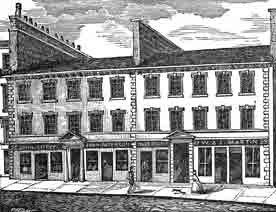Elephant and Black Boy Tavern.
27-39 Gallowgate Glasgow.

The Elephant and Black Boy Tavern. 1870s.
The Black Boy Tavern, Gallowgate was situated not far from Glasgow Cross near where the Chrystal Bell's now sits.
The Black boy, recalls the fashion of black boys pages, and in after years the Black Boy Close was notorious for robberies and several murders. It now forms part of the D. and F. Warehouse at the Cross.
A well-known Glasgow citizen, in touring round the world, landed at a township near the Fraser River, Brittish Columbia, and was accosted by a well-dressed well set-up man. After a conversation he said, "Tou come from Glasgow." "Yes," said Mr L "Did you know the Black Boy Close?," "Yes," again was the reply. "Well, "said the speaker," I was born there, and now I am Mayor of this town."
In the two following years the tavern keeper was James Boyd, who provided dinner to the Provost, Bailies, and Council and "other honest men." These dinners were usually associated with the riding or "reeding" of the marches, or boundaries marked by march stones, the first perambulation recorded being the date 1st June, 1574. The custom was discontinued, but a record of these stones was kept.
In an anecdote of Glasgow, written by Robert Alison and published in 1892 was a story of the Black Boy Tavern, he wrote the following: "During the commercial crisis and panic of 1837 which swept over the country, Glasgow, as a great merchantile and industrious centre, suffered severely. Prices of all kinds of manufactured goods sunk to nearly one half; many workers were thrown idle, and the wages of those still employed were reduced, which reduction again led to general and foolish strikes, at the instance of their trades unions, of the whole Colliers and Iron miners in Lanarkshire.
The effect of these two strikes was to let loose, upon an already over-distressed community, above 80 thousand persons, all in a state of utter destitution, and yielding implicit obedience to their trade leaders. To cope with this formidable and well-organised body there, was in and around Glasgow, a police force to only two hundred and eighty men.
Bands of eight hundred to a thousand men traversed the streets, with banners flying and drums beating; and the colliers assembled in such numbers as to render any attempt to dispose them, except by military force, out of the question. Many violent assaults were made on the nobs or new hands, who took the place of the men out on strike, and at length, on the 22nd July of that year, a new hand was shot dead on one of the street of Glasgow.
The masters met and offered a reward of £500 for the discovery of the persons implicated in the murder, and three days afterwards 2 informers met sheriff Alison by appointment in a Vault under the Old College, to which the informers were admitted by a back door through the College green. They disclosed to the sheriff a plot "to assassinate the new hands and masters, manufacturers in Glasgow, one after another, till the demand of the combined workmen were complied with" that the men shot three days before had been selected at the first victim and that Mr Arthur, master-manufacturer, was to be the next victim. The informers told the sheriff that the next meeting of committee would be held on the evening of Saturday 29th July, in the Black Boy Tavern, Gallowgate, Glasgow.
At 9 o'clock that night the sheriff left his office, with no arms but his walking stick, accompanied by Mr Salmond the procurator fiscal, and Mr Nish, the principal sheriff- officer. They met Captain Miller of the Police Force, with 20 constables, at the mouth of the Gallowgate, near to the Cross. Four constables were stationed at the entrance of the close, with instructions to let no one out or in; 12 others were stationed round the tavern at the front, and 4 at the back, with orders to seize anyone attempting to escape.
Sheriff Alison, Mr Salmond, Captain Miller and Mr Nish then entered the tavern. They at once passed by a trap-door, in the chief room, and to which they ascended by a moveable wooden stair or ladder into the room above, Captain Miller first, the sheriff second, Mr Salmond and Mr Nish following in rotation. They found the whole committee, 16 in number, seated round a table in consultation, with a lot of money spread out before them, and only one light from a gas pendant descending from the roof, lighting the apartment. The sheriff brought up 8 of the police, whom he stationed in the room below, re-entered the upper room and took up his position under the gas light to prevent it from being put out. He them looked round and saw that the committee were so panic-struck that no resistance would be offered, though they were in the room 4 to 1. Captain Miller next called out the names of each member of the committee, and as each was named, beckoned him to go out and they were thus one by one secured by the police in the room below. Not a blow was struck, so coolly, quietly, and firmly did sheriff and other officials go about their work.
On Monday following (31st July) the cotton-spinners met on Glasgow Green, and by a great majority resolved to resume their work on the masters terms; and on Tuesday the courageous sheriff had the delight of seeing the whole of the tall chimneys in Calton and Bridgeton sending forth their wanted smoke, after a stoppage of three months. The trial of the cotton-spinners came on at Edinburgh on 8th January 1838 and resulted in the whole of the would-be assassins receiving sentence of transportation for seven years.
In 1858 reporter Shadow, brought out a book entitled Midnight Scenes and Social Photographs, Glasgow. He describes how (with a couple of friends for reasons of safety) he followed an evil-looking woman from Glasgow Cross along the Gallowgate. She was helping alone a young man who was half drunk. Shadow and his friends followed them into a court off the Gallowgate and entered a two-roomed house and an earthen floor. There were four beds in the two rooms and two loathsome women in each bed.
As we smell the whisky, writes "Shadow" and pass it round, a feeling of disappointment is evidently felt, "I doot you dinna like the whisky," says Jenny. "It's real gude by what we get maist times at this time o'night." I daresay it is, we remark, "It can't be expected good at so late an hour. A proposal is made to form a circle round the fire, and enjoy ourselves. However giving a significant look to the young man, who by this time is again beginning to be a little elevated, we make our way towards the door, but find it locked. A trifle of money to the door-keeper, who remonstrates against our leaving, and we forthwith our departure, congratulating ourselves on an escape from a very dangerous den of the worst of thieves and prostitutes.
To read more on the pubs on the Gallowgate read up & Doon the Gallowgate by John Gorevan. A copy can be bought for a few pounds at the Hielan Jessie on the Gallowgate or contact me at john@oldglasgowpubs.co.uk
End.
